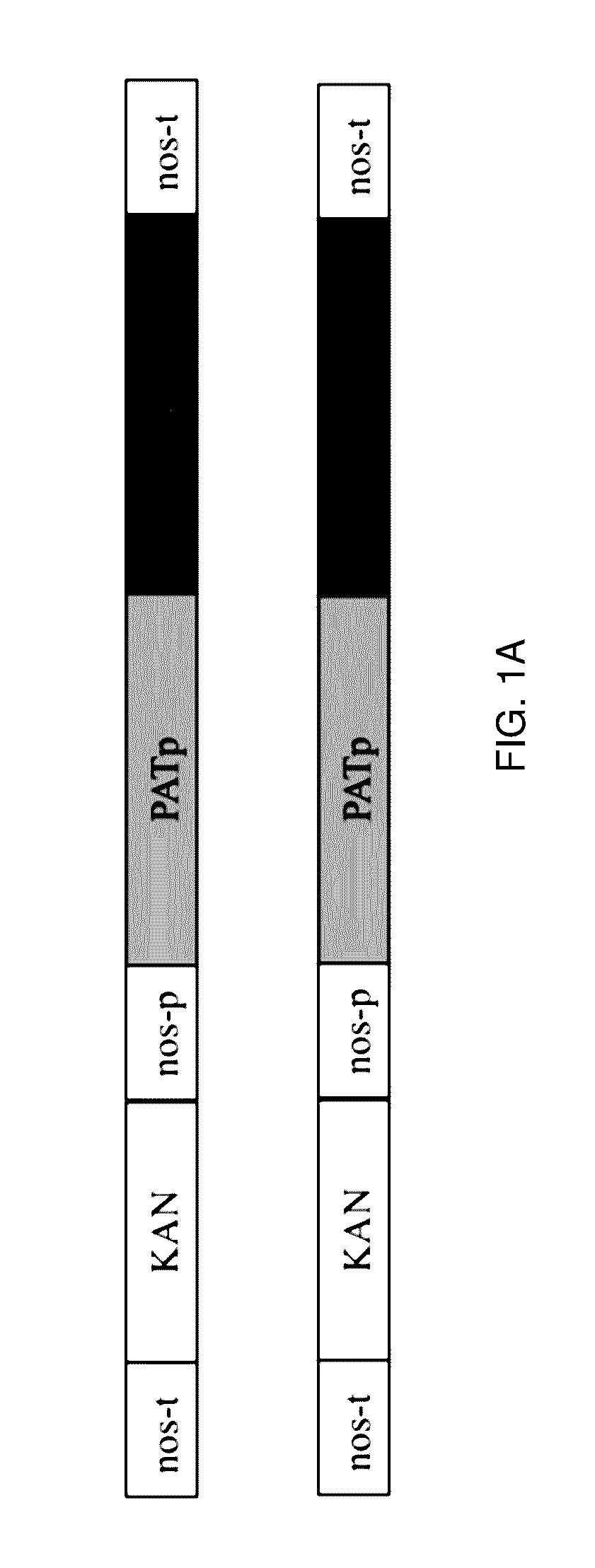Methods And Materials For Producing Enhanced Sugar, Starch, Oil, And Cellulose Output Traits In Crop Plants
a technology of crop plants and output traits, applied in biochemistry, hydrolases, enzymes, etc., can solve the problems of affecting the efficiency of carbonaceous products, and affecting the yield of crop plants, so as to improve the efficiency and yield of carbonaceous products, the effect of increasing sugars and sugar-derived polymers
- Summary
- Abstract
- Description
- Claims
- Application Information
AI Technical Summary
Benefits of technology
Problems solved by technology
Method used
Image
Examples
example 1
Materials and Methods
[0115]Asnase Expression Construct.
[0116]The following constructs were designed and produced for use in potatoes. The same or similar constructs may be used in other crop varieties. Changes in promoter allow for tissue-specific expression of Asnase in a target plant. Coding sequences for asparaginase from other plant varieties may also be used. From the disclosure herein, one of ordinary skill in the art will be able to adapt the construct for a desired purpose.
[0117]The coding regions for both the potato and soybean asparaginase (Asnase) genes were cloned by using PCR to amplify the region from cDNA derived from RNA isolated from potato tubers and immature soybean (150 mg) cotyledons, respectively. Total RNA was isolated using Trizol and then used as a template for cDNA by SuperscriptII First Strand Synthesis System (Invitrogen) using oligo T primer according to manufacturer's instructions. PCR was then performing using specific Asnase primers, for either potato...
example 2
Cytosolic Localization of Asnase and Metabolic Changes Resulting from Increased Asnase
[0131]Fusion cassettes with both the potato and soybean Asnase open reading frames were produced by digesting and moving the open reading frames into the vector, placing the Asnase coding regions in frame with yellow fluorescent protein (YFP) behind the enhanced 35S CaMV promoter. Onion epidermal cell layers were obtained from fresh onions and bombarded with fluorescent protein (YFP) behind the enhanced 35S CaMVp. Post-bombardment tissue was kept moist in dark conditions and monitored periodically for YFP expression. Expression was seen as early as 4 hr post-bombardment and continued for the following 3-4 days.
[0132]Agroinfiltration of fully expanded tobacco (Nicotiana tabacum Samsung) leaves in planta was performed using the YFP fusion cassettes in Agrobaterium tumefaciens LBA4404. Tobacco tissues were infiltrated with a syringe into intercellular spaces. Infiltrated tissues were covered and the p...
example 3
Reduction of Free Asn in Potato Tuber Shows Asn Reduction can be Targeted to be an Organ-Specific Trait
[0142]Transgenic potatoes were produced to test whether potatoes expressing ectopic Asnase could achieve decreased Asn levels. To accomplish this, both soybean and potato Asnase were ectopically expressed in potato tubers under the control of the patatin tuber-specific promoter. The resulting Asnase over-expressing potatoes exhibited 55-75% reduction in free Asn in the tubers, while the potato's plant growth, overt productivity, as well as size of the potatoes produced, was similar to controls (FIG. 11).
[0143]As with tobacco, the potato results showed enhanced crop value from reducing free Asn. The results showed that compositional changes can be induced by causing plants to rebalance their carbon allocation, resulting in accelerated vegetative and root growth and shifting the allocation of carbon to carbonaceous output traits. Refining this engineering strategy with combinations o...
PUM
| Property | Measurement | Unit |
|---|---|---|
| Fraction | aaaaa | aaaaa |
| Stress optical coefficient | aaaaa | aaaaa |
Abstract
Description
Claims
Application Information
 Login to View More
Login to View More - R&D
- Intellectual Property
- Life Sciences
- Materials
- Tech Scout
- Unparalleled Data Quality
- Higher Quality Content
- 60% Fewer Hallucinations
Browse by: Latest US Patents, China's latest patents, Technical Efficacy Thesaurus, Application Domain, Technology Topic, Popular Technical Reports.
© 2025 PatSnap. All rights reserved.Legal|Privacy policy|Modern Slavery Act Transparency Statement|Sitemap|About US| Contact US: help@patsnap.com



